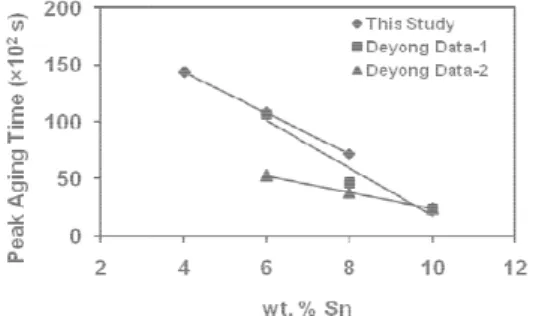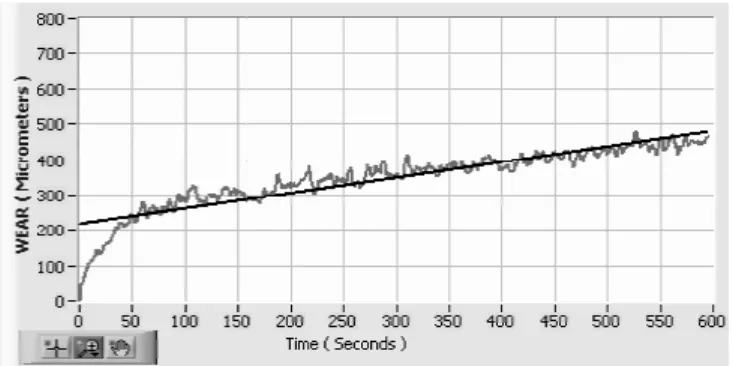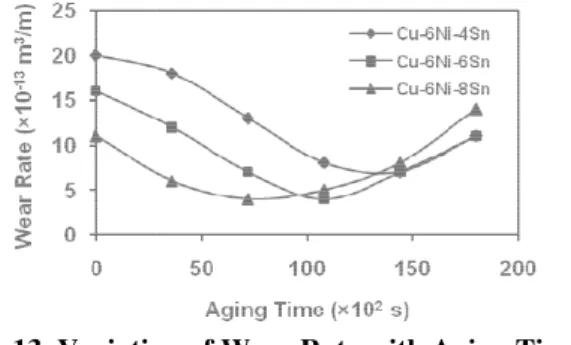Journal of Engineering Science and Technology Vol. 8, No. 1 (2013) 34 - 43
© School of Engineering, Taylor’s University
34
EFFECTS OF TIN ON HARDNESS, WEAR RATE AND
COEFFICIENT OF FRICTION OF CAST CU-NI-SN ALLOYS
S. ILANGOVAN*, R. SELLAMUTHU
Amrita Vishwa Vidyapeetham, Amrita School of Engineering, Amrita University, Ettimadai Campus, Coimbatore, Tamilnadu, India
*Corresponding Author: s_ilangovan@cb.amrita.edu
Abstract
An investigation was carried out to understand the effects of Sn on hardness, wear rate and the coefficient of friction of spinodal Cu-Ni-Sn alloys. Alloys of appropriate compositions were melted in a crucible furnace under argon atmosphere and cast into sand moulds. Solution heat treated and aged specimens were tested for hardness, wear rate and the coefficient of friction. It was found that the hardness increases when the Sn content increases from 4% to 8% in the solution heat treated conditions. The peak aging time is found to decrease with an increase in the Sn content. Further, the coefficient of friction is independent of hardness whereas the wear rate decreases linearly with hardness irrespective of Sn content.
Keywords: Cu-Ni-Sn alloy, Coefficient of friction, Spinodal decomposition, Wear rate, Heat treatment.
1. Introduction
Effects of Tin on Hardness, Wear Rate and Coefficient of Friction of …… 35
Journal of Engineering Science and Technology February 2013, Vol. 8(1)
Nomenclatures
Cu Copper
DO22 Microstructure of ordering reaction
DO3 Microstructure of grain boundary precipitates HRC Rockwell Hardness in C scale
Ni Nickel
Ra Roughness average value
Sn Tin
wt.% Weight Percentage
Greek Symbols
α
Alpha phaseµ
Coefficient of frictionreported that the strength of the alloy increases up to three times depending on (i) alloy composition (ii) amount of cold work prior to aging and (iii) aging temperature [4].
A number of studies were conducted on spinodal bronze (Cu-Ni-Sn) alloys to assess the microstructures and the mechanical properties, but a limited studies were conducted to determine the wear behavior as these alloys are potential candidates likely to be used in high performance wear applications [9, 10]. Deyong et al. have reported the effect of Sn content on the hardness of Cu-Ni-Sn alloys while keeping Ni fixed at 10 wt. % [11]. Zhang et al. [9, 10] have studied the wear behavior of Cu-15Ni-8Sn spinodal alloy in relation to the hardness whereas Singh et al. [12] have investigated the wear behavior of Cu-15Ni-8Sn alloy with respect to the type of debris that formed during wear testing. Further, Deyong et al. [11] have used both rapid and normal cooling method to prepare their alloys. They have specified melt-spinning as the technique to obtain extremely high cooling rate while they have not stated how they made the normal cooling rate alloys.
Since Cu-Ni-Sn alloys are likely candidates to be used in bearings, wear plates etc., in critical applications, it is necessary to evaluate the wear behavior with respect to various alloy compositions, aging temperature and time. Since casting is the most economical manufacturing process, an investigation with reference to a specific casting method is highly warranted. This will lead to wide application for these alloys. Therefore, in this present study, the effects of Sn on hardness, wear rate and the coefficient of friction of Cu-Ni-Sn alloys while keeping Ni content constant is discussed. Additional information sought in this work is the contributing effect of Sn to the spinodal process when it is increased from a low to a high concentration. Further, green sand casting method has been used to make the specimens for this study.
2. Experimental Procedures
36 S. Ilangovan and R. Sellamuthu
Journal of Engineering Science and Technology February 2013, Vol. 8(1) of the size diameter 0.016 m × 0.15 m lengths. After the casting process, the chemical compositions of the castings were analyzed using spectrometer. The spectroscopy results are reported in Table 1. The alloy compositions were found to be within a variation of ± 0.2 wt. % from the nominal composition.
Table 1. Spectroscopy Results of the Alloy Compositions. Element Cu-6Ni-4Sn Cu-6Ni-6Sn Cu-6Ni-8Sn
Ni 6.2 6.2 6.2
Sn 3.9 5.8 8.0
Cu Balance Balance Balance
The cast specimens were homogenized at 820°C for 10 hours and cooled in the furnace itself. Solution heat-treatment was performed for 1 hour at 820°C and rapidly quenched in water in order to maintain the phase (solid solution of Sn and Ni in Cu) in the supersaturated condition. Solution heat treated specimens were then aged for 1 to 5 hours at 350±5°C and water quenched. All the above heat treatment procedures were performed under inert nitrogen atmosphere. Test specimens were prepared from as cast, homogenized, solution treated and aged conditions for various measurements.
The Mitutoyo make (USA) hardness tester was used to measure the micro-hardness of the specimens at various locations and an average value was calculated from several readings.
The specimens required for friction and wear tests were machined to a size of diameter 0.01m × 0.035 m lengths. The Ducom make (Bangalore, India) pin-on-disc tribometer was used to conduct the test in dry sliding condition in air. The counter-part rotating disc was made from EN31 alloy steel stock and hardened to 63 HRC with surface roughness of Ra 0.15 µm. Table 2 shows the fixed parameters used for conducting the tests.
Table 2. Friction and Wear Testing Parameters. Test Parameters Unit Test Values
Speed rpm 636
Velocity m/s 3
Track Radius m 0.045
Time s 600
Sliding Distance m 1800
Load Applied N 20
Following were determined using the data obtained from the data acquisition system available in the tribometer: (i) height loss, m versus time, sec (ii) coefficient of friction versus time, sec and (iii) frictional force versus time, sec. The wear rate expressed as m3/m (volume loss per meter sliding distance).
Effects of Tin on Hardness,
Journal of Engineering Scienc
3. Results and Discussion
A typical as-cast dendritic micro The dendritic structure was fu solution heat treatments as show
Fig. 1. Typical As-Cast Mic structure of Cu-6Ni-8Sn All
As reported previously, the an ordering reaction (DO22stru 8]. The modulated and the orde by the optical microscopy [9].
Figure 3 shows the micros When the specimen is over-ag boundaries, an observation in a Cu-15Ni-8Sn alloy [9]. It has b are equilibrium and (DO3) p upon prolonged aging [9]. We therefore Fig. 3 does not show Zhang et al. [9] have noted that aging whereas it took three hour attributed to the difference in the
Fig. 3. Microstru Alloy Showing
Figure 4 shows the variati function of aging time. As the a
, Wear Rate and Coefficient of Friction of …… 37
nce and Technology February 2013, Vol. 8(1) crostructure of Cu-6Ni-8Sn alloy is shown in Fig. 1. fully eliminated by the homogenization and the own in Fig. 2.
icro- Fig.2 Typical homogenized and lloy. Solution Heat Treated Micro-structure of Cu-6Ni-8Sn Alloy.
e spinodal decomposition (modulated structure) and ructure) takes place during the aging process [4, 6-dered structures are very fine and cannot be resolved
rostructure of Cu-6Ni-8Sn alloy aged for 3 hours. aged, precipitates started to form along the grain agreement with that of Zhang et al. in the case of s been reported that the grain boundary precipitates ) phases [4, 6, 7, 9] and completely fills the structure e have aged our specimens for a short period and w complete filling with equilibrium phases. Further, at equilibrium precipitates form within one hour of urs in our case and the difference in this behavior is the Ni content.
ructure of 3 Hours Aged Cu-6Ni-8Sn ing Grain Boundary Precipitates.
38 S. Ilangovan and R. Sella
Journal of Engineering Scienc
maximum and decreases as can attributed to the change in mi formation of modulated and or hardness to a maximum value formation of grain boundary pre hardness [4, 6, 7, 9].The trend o Zhang et al. [9] for Cu-15Ni-8S be concluded that the hardness o
Fig. 4. Variatio
Figure 5 shows the variation Included in the figure are the d pertaining to (i) rapid solidifi conventional ingot casting (Data 10, 12 wt. percentages of Sn with the plot that in all the three case behavior observed in this study Also it is to be noted that the mag different from each other and t content and aging temperature. increase in Sn content increases t
Fig. 5. Variation o
The variation of the peak ag along with the data of Deyong Fig. 6 that the peak aging time three cases. It is observed for marginally varies between this s
llamuthu
nce and Technology February 2013, Vol. 8(1) n be noted in Fig. 4. The variation in the hardness is microstructure of the specimen during aging. The ordered meta-stable (DO22) structures increases the ue during the aging process and subsequently, the precipitates (equilibrium and (DO3)) reduces the d observed in this study is in agreement with that of 8Sn alloy and Deyong et al. [11]. Therefore, it can s of a given alloy is dependent on the aging time.
tion of Hardness with Aging Time.
ion of peak hardness with Sn content of this study. data of Deyong et al. [11] taken from their results ification by melting spinning (Data -1) and (ii) ta-2) for aging at 400°C of various alloys having 6, 8, ith fixed Ni content of 10 wt. %. It is observed from ses the peak hardness increases with Sn content. The dy is in agreement with Deyong et al. data 1 and 2. agnitude of the peak hardness observed is marginally this difference is attributed to the difference in Ni . Therefore, it is concluded from the results that an s the peak hardness of the alloy.
n of Peak Hardness with Sn Content.
Effects of Tin on Hardness,
Journal of Engineering Scienc
be due to the variation in the Ni Ni and Deyong-10% Ni). So we Sn content reduces the peak agi the studies whether rapid solidif time or not. Hence, a further stu time is necessary.
Fig. 6. Variation o
In order to know the effect look at two different aspects hardening due to dissolved Sn s the formation of modulated stru deduce the contribution by Case the hardness against the Sn con Fig. 7. It can be seen from th content, thereby illustrating it aspect. Next, we have also plo treatment in the same figure (Fi spinodal hardening, Case (ii). I with the Sn content. An importa cases are almost parallel and incremental contribution due to from 4 to 8 wt%.
Fig. 7. Variation of H
Figure 8 shows the same typ for the data of Delong et al. in alloys and these lines are also p study and the data of Delong spinodal hardening when its con
, Wear Rate and Coefficient of Friction of …… 39
nce and Technology February 2013, Vol. 8(1) Ni content between these two studies (this study-6% we may conclude from this result that an increase in ging time of the alloy. However, it is not clear from dification contributes to a decrease in the peak aging tudy to assess the effect of cooling rate on the aging
of Peak Aging Time with Sn Content.
ct of Sn on the hardening process, it is necessary to s of strengthening mechanisms: (i) solid solution solutes in the matrix, (ii) spinodal hardening due to tructure along with ordering reaction. As a way to se (i) from the experimental values, we have plotted ontent in the solution treated condition as shown in the figure that the hardness increases with the Sn its contributing effect to the solution hardening lotted the experimental values pertaining to aging (Fig. 7) in order to assess the Sn contribution to the . In the Case (ii) also, the peak hardness increases rtant point to be noted is that the trend lines for both nd therefore, it can be inferred that there is no to spinodal hardening by increasing the Sn content
Hardness with Sn Content (This Study).
40 S. Ilangovan and R. Sella
Journal of Engineering Scienc
Sn content does not contribut spinodal/order hardening and (i hardness due solution hardening
Fig. 8. Variation of Har
Frictional force versus time frictional force remains constan initially increases rapidly du counterpart mating surface. Onc remains constant.
Fig. 9. Fri
A typical plot of coefficient shown in Fig. 10. The plot sho regime. The effect of work-har reasons for the transient behavio around 0.43 as shown in Fig. 10
Fig. 10. Coeff
llamuthu
nce and Technology February 2013, Vol. 8(1) ute significantly to the increase in hardness due (iii) Sn contributes significantly to the increase in ng effect.
ardness with Sn Content (Deyong Data-1).
e plot (Fig. 9) of Cu-6Ni-8Sn alloy shows that the ant after a short period of time. The frictional force due to uneven contact between specimen and nce perfect contact is achieved, the frictional force
rictional Force vs. Time Plot.
nt of friction (µ) versus time for Cu-6Ni-8Sn alloy is shows both transient period and single steady-state ardening and/or accumulation of debris may be the vior [12]. The COF value is constant and is equal to 10.
Effects of Tin on Hardness,
Journal of Engineering Scienc
Figure 11 shows the variati The value of COF is found to be the alloy does not affect the agreement with that of Zhang e noted that the COF value diff which may be due to use of d surface finish, working atmosph that COF value is not affected b line with the previous research need for aging treatment for C maintained /specified.
Fig. 11. Var
Wear versus time plot (Fig linearly increases with sliding Singh et al. [12].
Fig. 12. A Typical W
Figure 13 shows the variati alloys. It is observed from the fi and alloy compositions. The var alloy, which varies with aging consistent with that of Zhang. T addition of Sn content reduces w varies with aging time in the cas
, Wear Rate and Coefficient of Friction of …… 41
nce and Technology February 2013, Vol. 8(1) ation of COF with hardness of Cu-6Ni-xSn alloys. be around 0.43 with marginal variation. Hardness of e COF value. An observation of this study is in et al. [9, 10] and Singh et al. [12]. It is also to be iffer from each author (Singh:0.3 and Zhang:0.7), f different counter face materials and its hardness, phere etc. Hence, we may conclude from the results by the hardness of the alloy. The present study, in ch findings in this regard, indicates that there is no Cu-Ni-Sn alloys, if COF is the only factor to be
ariation of COF with Hardness.
ig. 12) of Cu-6Ni-8Sn alloy shows that the wear g time. This behavior is in agreement with that of
Wear vs. Time Plot of Cu-6Ni-8Sn Alloy.
ation of wear rate with aging time of Cu-6Ni-xSn figure that the wear rate varies with both aging time variation in wear rate corresponds to hardness of the ing time. The behavior observed in this study is . Therefore, it is concluded from the result that the s wear rate by increasing the hardness and wear rate
42 S. Ilangovan and R. Sella
Journal of Engineering Scienc
Fig. 13. Variatio
Figure 14 shows a set of w and various aging conditions against hardness. The trend line of the alloy and follows the adhe
Fig. 14. Variati
4. Conclusions
Following conclusions were ma spinodal decomposition of supe present in the amount of around alloys; further increase of Sn c significantly to the spinodal/ord solution hardening; the peak agi coefficient of friction is indepe 0.43; the wear rate decreases lin
References
1. Brush Wellman, (2001). Stre 2. Schwartz, L.H.; Mahaja
decomposition in a Cu-9 w 601-609.
llamuthu
nce and Technology February 2013, Vol. 8(1) tion of Wear Rate with Aging Time.
wear rate data obtained under solution heat treated s of the Cu-6Ni-xSn alloys that has been plotted ne shows that the wear rate decreases with hardness
hesion theory of wear proposed by Archard [13].
ation of Wear Rate with Hardness.
made based on the results of this study: Sn induces persaturated solid solution during aging when it is nd 4wt. % in the sand cast specimens of Cu-Ni-Sn n content from 4 upto 8wt. % does not contribute order hardening; Sn contributes significantly to the ging time decreases with increase in Sn content; the pendent of hardness and remains around a value of linearly with hardness irrespective of Sn content.
trengthening Mechanisms.Technical Tidbits, 3, 1-2. jan, S.; and Plewes, J.T. (1974). Spinodal
Effects of Tin on Hardness, Wear Rate and Coefficient of Friction of …… 43
Journal of Engineering Science and Technology February 2013, Vol. 8(1) 3. Schwartz, L.H.; and Plewes, J.T. (1974). Spinodal Decomposition in a Cu-9 wt% Ni-6 wt% Sn-II, a critical examination of mechanical strength of spinodal alloys.Acta Metallurgica, 22(7), 911-921.
4. Kratochvil, P.; Mencl, J.; Peši ka, J.; and Komnik, S.N. (1984). The structure and low temperature strength of the age hardened Cu-Ni-Sn alloys. Acta Metallurgica, 32(9), 1493-1497.
5. Kato, M.; and Schwartz, L.H. (1979). The temperature dependence of yield stress and work hardening in spinodally decomposed Cu-10Ni-6Sn alloy.
Materials Science and Engineering, 41(1), 137-142.
6. Baburaj, E.G.; Kulkarni, U.D.; Menon, E.S.K.; and Krishnan, R. (1979). Initial stages of decomposition in Cu-9Ni-6Sn. Journal of Applied Crystallography, 12(5), 476-480.
7. Zhao, J.-C.; and Notis, M.R. (1998). Spinodal decomposition, ordering transformation, and discontinuous precipitation in a Cu-15Ni-8Sn alloy.Acta Materialia, 46(12), 4203-4218.
8. Sato, A.; Katsuta, S.-I.; and Kato, M. (1988). Stress aging of a Cu-10Ni-6Sn spinodal alloy.Acta Metallurgica, 36(3), 633-640.
9. Zhang, S.-Z.; Jiang, B.-H.; and Ding, W.-J. (2008). Wear of Cu-15Ni-8Sn spinodal alloy.Wear, 264(3-4), 199-203.
10. Zhang, S.; Jiang, B.; and Ding, W. (2010). Dry sliding wear of Cu-15Ni-8Sn alloy.Tribology International, 43(1-2), 64-68.
11. Deyong, L.; Tremblay, R.; and Angers, R. (1990). Microstructural and mechanical properties of rapidly solidified Cu-Ni-Sn alloys. Materials Science and Engineering A, 124(2), 223-231.
12. Singh, J.B.; Cai, W.; and Bellon, P. (2007). Dry sliding of Cu-15 wt%Ni-8 wt%Sn bronze: Wear behaviour and microstructures.Wear, 263(1-6), 830-841. 13. Archard, J.F. (1953). Contact and rubbing of flat surfaces.Journal of Applied





